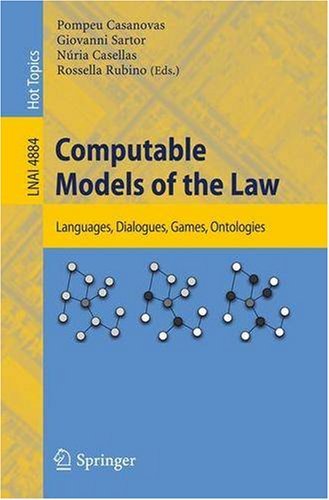Reviewed by
Francesca Giardini
ISTC-CNR Rome
 Intuitively, law and ICT are two disciplines that seem to have nothing in common in terms of problems, methodologies and solutions. This book shows that this assumption is erroneous and that the collaboration between researchers coming from the law domain and computer scientists has led to the constitution of a new and stimulating interdisciplinary research field.
Intuitively, law and ICT are two disciplines that seem to have nothing in common in terms of problems, methodologies and solutions. This book shows that this assumption is erroneous and that the collaboration between researchers coming from the law domain and computer scientists has led to the constitution of a new and stimulating interdisciplinary research field. The diffusion of ICT tools in legal activities and, on the other hand, the success of computational models of legal knowledge and cognition have prompted the interest of national and European funding agencies and has opened new directions of research. In fact, legal technologies offer the possibility of improving the daily routines of legal professionals, smoothing processes and interactions required for several activities (e.g., legislative drafting, information retrieval, dispute resolutions).
This volume contains a collection of twenty research contributions on what the authors define "the hot topics under research in the EU projects" (from the Preface). The sample of European or EU-supported projects dealing with legal technologies and computable models of the law is quite broad, and the papers are grouped into five parts. The book is organized into topical sections, although the editors should devote some lines to explain the criteria behind this division.
The sections are:
* Knowledge Representation, Ontologies and XML Legislative Drafting (this section presents contributions from projects proposing different tools for improving the quality of legislative drafting through ontologies, linguistic resources and legal knowledge representation tools);
* Knowledge Representation, Legal Ontologies and Information Retrieval (here, the authors present results coming from different projects in which legal ontologies and new tools for knowledge representation and information retrieval in the legal domain have been developed and tested);
* Argumentation and Legal Reasoning (this section provides both theoretical and implementative contributions about argumentation and reasoning in the legal domain);
* Normative and Multi-Agent Systems (in this part of the book two contributions are included, the first one deals with the analysis of concepts of norms, whereas the second contribution presents an application of norms into Multi-agent Systems. This section should be the most interesting for JASSS readers, but the contributions presented are quite limited in scope);
* Online Dispute Resolution (here, the papers presented revolve around the usage of internet for alternative dispute resolution methods and applications).
In the Preface, the authors explain that this volume stems from a workshop on models and technologies of contemporary law and from the consequential assumption that there are multiple ways of interpreting the law and of making it computable. In general, the book looks a little bit unsystematic, partially due to its being a collective volume, but also to the editors' choice of including many different projects, each one addressing a specific issue. It would have been nice to have texts between the sections, establishing bridges and opening up spaces for confrontation, and also to introduce a section summing up which issues the book addressed and which questions have remained open.
The heterogeneity of problems and results presented in this book results in both its strengths and weaknesses. On the plus side, this book offers an updated and broad view on legal technologies, their applications and open issues. This can be useful for people not already familiar with legal technologies, who can find here a complete review of what is going on in this field, what issues have been addressed and solved, how this has been achieved and what advancements are needed.
So, if you are interested in knowing who has worked on what regarding ICT for the law, this book may be helpful. On the other hand, if you are already an expert in the field, this volume allows you to get an updated state-of-the-art in the field of legal technologies in Europe, but if you want details about either the implementation or the theoretical issues, you will be somewhat disappointed.
Return to Contents
of this issue
© Copyright Journal of Artificial Societies and Social Simulation, 2009